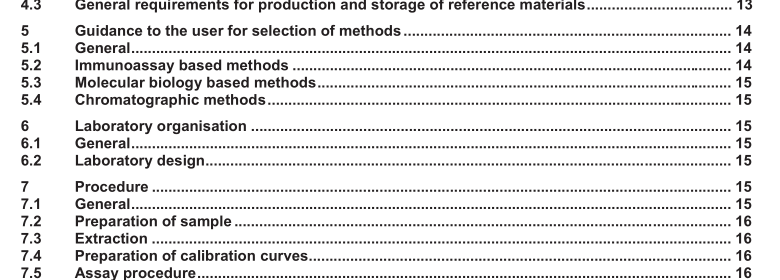EN 15842:2010 – Foodstuffs – Detection of food allergens – General considerations and validation of methods

4.2 Reference method A reference method for the determination of allergenic food commodities should be independent of any technological influences and matrix effects, in order to reliably measure one or more property values characteristic of the allergen concerned. The reference method’s accuracy and precision should be commensurate with its intended use and permit the characterization of a reference material. Reference materials may be used to calibrate instruments, to determine trueness/bias of a method (validate a method) and to assign values to testing materials.
In case of bias, checking the results obtained from a CRM by using a certain analytical method may be compared to the certified property value. If the absolute difference of the two sets of values (obtained values and certified value) exceeds the expanded uncertainty of this difference, the analytical method is considered to be biased (one or more systematic errors occurred). See also ISO Guide 32 [11] and ISO Guide 33 [12].
4.3 General requirements for production and storage of reference materials The reference material producer shall identify and plan those processes which directly affect the quality of reference material production and shall ensure that they are carried out in accordance with specified procedures (e.g. ISO Guide 35).
It is imperative that all possible precautions are taken against possible contamination of the reference material during its production and certification. In order to avoid any contamination, the reference material producer shall identify, preserve and segregate (i.e. from other chemicals and samples) all candidate materials and reference materials, from the time of preparation through to their distribution to users. The reference material producer shall ensure adequate packaging of all reference materials (e.g. where appropriate, use air-free, moisture-free or inert-gas packaging) and provide secure storage areas/stock rooms which prevent damage or deterioration of any item or material between characterization and distribution. Appropriate methods for authorizing dispatch to, and receipt from, such areas should be stipulated.
The condition of all stored/stocked items and materials shall be assessed at appropriate intervals throughout their storage life, in order to detect possible deterioration. The reference material producer shall be able to demonstrate that the candidate reference material is sufficiently homogeneous; i.e. the difference, if any, between units shall be smaller than the uncertainty limits stated in the certificate.
NOTE A relatively inhomogeneous material may be the best available, and may therefore still be useful as a reference material, provided the uncertainties of the assigned property values take due account of this. Where appropriate, the property values to be assessed should be measured periodically, ideally over a range of conditions under which the material is to be stored prior to distribution to the user.
The effects of light, moisture, heat and time shall be quantified in order to provide advice on storage location and lifespan (and hence a suitable shelf-life/expiry date). Where appropriate, an assessment of the stability of the assigned property values of the reference material should be performed at periodic intervals after characterization to confirm that all values are maintained from production until its expiry date. Wherever appropriate, the reference material producer shall provide an expiry date for the usable life of the reference materials produced, based on initial and on-going stability studies in compliance with ISO Guide 35.
EN 15842:2010 – Foodstuffs – Detection of food allergens – General considerations and validation of methods